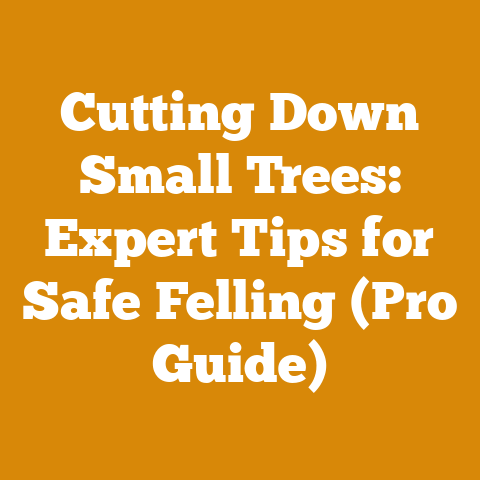How to Measure Board Feet in a Log (5 Pro Lumber Tools)
Ever been in a situation where you needed lumber and thought, “I could just mill that log myself,” only to be stumped by figuring out how much lumber you’d actually get?
There’s no quick fix, but I’ll share the secrets I’ve learned over the years.
Figuring out board feet in a log is crucial, whether you’re a seasoned logger, a weekend woodworker, or someone simply curious about the potential hidden within a fallen tree.
Knowing how to accurately measure board feet allows you to estimate the value of a log, plan your projects effectively, and avoid costly mistakes.
It’s a skill that bridges the gap between standing timber and usable lumber, and it’s far more practical than relying on guesswork.
In this guide, I’ll walk you through five professional lumber tools and techniques I use to measure board feet in a log.
I’ll break down the calculations, explain the tools, and share real-world examples from my experiences in wood processing and firewood preparation.
Let’s dive in!
Understanding the Basics: Board Feet, Logs, and Lumber
Before we get into the tools, let’s define some key terms to ensure we’re all on the same page.
Board Foot (BF): This is the standard unit of measurement for lumber.
One board foot is equal to a piece of wood that is 1 inch thick, 12 inches wide, and 12 inches long (1″ x 12″ x 12″).
Think of it as a cubic foot, but specifically for lumber.-
Log: A section of a tree that has been felled and trimmed, ready for processing into lumber.
Lumber: Wood that has been sawn into boards or planks.
Lumber can be “green” (freshly cut, with high moisture content) or “seasoned” (dried, with lower moisture content).
Green wood is heavier and more prone to warping, while seasoned wood is more stable and easier to work with.Scaling: The process of estimating the amount of usable lumber in a log.
It’s an essential skill for anyone involved in logging, milling, or buying timber.
Why Measuring Board Feet Matters
Accurate measurement of board feet is essential for several reasons:
- Valuation: Logs are bought and sold based on their board foot content.
Accurate measurement ensures fair pricing for both buyer and seller. - Project Planning: Knowing the board foot content of your logs allows you to plan your woodworking projects efficiently, ensuring you have enough material and minimizing waste.
- Resource Management: By accurately estimating the yield from your timber, you can make informed decisions about sustainable forestry practices.
- Profitability: If you’re milling your own lumber, knowing the board foot content helps you determine the profitability of your operation.
Tool #1: The Doyle Log Scale (and Why It’s Controversial)
The Doyle Log Scale is the oldest and perhaps most widely used log scaling method in North America, particularly in the Eastern and Southern United States.
It’s a simple formula that has been around for over a century.
The Formula
The Doyle Log Scale formula is:
Where:
BF= Board FeetD= Diameter of the small end of the log in inchesL= Length of the log in feet
How to Use the Doyle Log Scale
- Measure the Diameter: Use a diameter tape (more on this later) to measure the diameter of the small end of the log.
This is crucial, as the Doyle scale relies on the smallest diameter to account for taper.
Round down to the nearest whole inch.
For example, if the diameter is 12.7 inches, use 12 inches. - Measure the Length: Measure the length of the log in feet.
Round down to the nearest foot. - Apply the Formula: Plug the diameter and length into the formula.
Example:
Let’s say you have a log that is 16 feet long and has a small-end diameter of 12 inches.
The Controversy: Why the Doyle Scale Underestimates
The Doyle Log Scale is known to underestimate the actual board foot content of logs, especially for smaller logs.
This is because the formula was developed in a time when milling technology was less efficient, and more wood was lost to sawdust and slabs.
My Experience: I’ve seen firsthand how the Doyle scale can be misleading.
In one project, I milled a batch of logs that the Doyle scale estimated at 500 board feet.
However, after milling, I actually yielded closer to 700 board feet.
This discrepancy is why many experienced loggers and millers prefer other scales.
Why it’s still used: Despite its inaccuracies, the Doyle scale persists because of its simplicity and widespread adoption.
It’s easy to calculate and is often used as a standard in timber sales.
However, it’s crucial to be aware of its limitations.
When to Use (and When to Avoid) the Doyle Scale
- Use: If you’re buying or selling timber in an area where the Doyle scale is the standard, you’ll need to know how to use it.
- Avoid: If you’re milling your own lumber and want a more accurate estimate of your yield, consider using a different scale.
Tool #2: The Scribner Log Scale (A More Accurate Alternative)
The Scribner Log Scale is another common log scaling method, known for being more accurate than the Doyle scale, especially for smaller logs.
It’s based on diagrams that show the expected yield from logs of different sizes.
How the Scribner Log Scale Works
Instead of a formula, the Scribner scale uses a table or chart to look up the board foot content based on the diameter and length of the log.
These tables are readily available online or in forestry handbooks.
Using a Scribner Log Scale Table
- Measure the Diameter: As with the Doyle scale, measure the diameter of the small end of the log in inches.
Round down to the nearest whole inch. - Measure the Length: Measure the length of the log in feet.
Common log lengths are 8, 10, 12, 14, and 16 feet. - Consult the Table: Find the intersection of the diameter and length on the Scribner log scale table.
The number at that intersection is the estimated board foot content of the log.
Example:
Let’s say you have a log that is 12 feet long and has a small-end diameter of 14 inches.
Consulting a Scribner log scale table, you might find that a 14-inch diameter, 12-foot log yields 90 board feet.
Advantages of the Scribner Scale
- More Accurate: Generally provides a more accurate estimate than the Doyle scale, particularly for smaller logs.
- Widely Accepted: Used in many regions, making it a reliable standard for timber transactions.
Disadvantages of the Scribner Scale
- Requires a Table: You need to have a Scribner log scale table handy, which can be inconvenient in the field.
- Still an Estimate: Like all log scales, it’s still an estimate and doesn’t account for internal defects or variations in log quality.
My Experience with Scribner
I’ve found the Scribner scale to be a good compromise between accuracy and ease of use.
It’s my go-to method when I need a quick and reliable estimate of board feet in the field.
Tool #3: The International 1/4-inch Log Scale (The Gold Standard)
The International 1/4-inch Log Scale is considered the most accurate of the common log scales.
It is based on a formula that accounts for the kerf (the amount of wood lost to the saw blade) and the taper of the log.
The Formula
The International 1/4-inch Log Scale formula is a bit more complex than the Doyle scale, but it provides a more accurate estimate.
The formula calculates the board foot content for each 4-foot section of the log, then adds them together.
While the full formula is complex and rarely calculated manually in the field, tables based on the formula are readily available.
These tables provide the board foot content for logs of various diameters and lengths, similar to the Scribner scale.
How to Use the International 1/4-inch Log Scale
- Measure the Diameter: Measure the diameter of the small end of the log in inches.
Round down to the nearest whole inch. - Measure the Length: Measure the length of the log in feet.
- Consult the Table: Find the intersection of the diameter and length on the International 1/4-inch log scale table.
The number at that intersection is the estimated board foot content of the log.
Example:
Let’s say you have a log that is 10 feet long and has a small-end diameter of 16 inches.
Consulting an International 1/4-inch log scale table, you might find that a 16-inch diameter, 10-foot log yields 120 board feet.
Advantages of the International 1/4-inch Log Scale
- Most Accurate: Considered the most accurate of the common log scales, as it accounts for kerf and taper.
- Widely Respected: Used as a standard in many regions, especially for high-value timber.
Disadvantages of the International 1/4-inch Log Scale
- Requires a Table: Like the Scribner scale, you need to have a table handy.
- Still an Estimate: It’s still an estimate and doesn’t account for internal defects.
My Experience with the International 1/4-inch Scale
When I’m dealing with valuable hardwoods like walnut or cherry, I always use the International 1/4-inch scale.
The extra accuracy is worth the effort, as it ensures I’m getting a fair price for my timber.
Tool #4: Diameter Tape (Crucial for Accurate Measurement)
While the log scales provide the formulas and tables, the diameter tape is the tool you’ll use to get the crucial diameter measurement.
A diameter tape, also known as a D-tape, is a specialized measuring tape that directly reads the diameter of a log when wrapped around its circumference.
How a Diameter Tape Works
A standard measuring tape measures linear distance.
A diameter tape, however, is calibrated so that when you wrap it around the circumference of a log, it displays the diameter directly.
This eliminates the need to measure the circumference and then divide by pi (π) to calculate the diameter.
Using a Diameter Tape
- Position the Tape: Place the tape around the small end of the log, ensuring it’s perpendicular to the log’s axis.
- Wrap the Tape: Wrap the tape snugly around the log, making sure it’s not twisted or kinked.
- Read the Diameter: Read the diameter directly from the tape where it overlaps.
Important Considerations:
- Bark: For the most accurate measurement, remove any loose bark from the log before measuring.
- Out-of-Round Logs: If the log is significantly out-of-round, take multiple measurements at different angles and average them.
- Tape Quality: Invest in a good-quality diameter tape.
A cheap tape can stretch or be inaccurate, leading to errors in your board foot calculations.
My Preferred Diameter Tape
I personally prefer a durable steel diameter tape with clear, easy-to-read markings.
I’ve found that the Stanley 33-726 25-Foot Diameter/Circumference Tape is a reliable option.
It’s affordable, accurate, and can withstand the rigors of field use.
Why a Diameter Tape is Essential
You might be tempted to use a regular measuring tape to measure the circumference and then calculate the diameter.
However, this method is prone to errors.
A diameter tape is specifically designed for this task, making it faster, easier, and more accurate.
Tool #5: Log Scaling Software and Apps (Modern Efficiency)
In today’s digital age, there are numerous log scaling software programs and mobile apps that can streamline the process.
These tools can automate the calculations, store log data, and even generate reports.
How Log Scaling Software Works
Log scaling software typically allows you to input the diameter, length, and species of the log.
It then uses the selected log scale (Doyle, Scribner, International 1/4-inch, etc.) to calculate the board foot content.
Some software programs also allow you to account for defects, such as rot or knots, to get a more accurate estimate of the usable lumber.
Case Study: Using Log Scaling Software for Firewood Production
I recently used log scaling software to optimize my firewood production.
I measured a large pile of logs using the app, and it calculated the total board foot content.
Based on this information, I was able to estimate the amount of firewood I could produce and price it accordingly.
The software also helped me track my inventory and manage my sales.
Choosing the Right Log Scaling Software
When choosing log scaling software, consider the following factors:
- Ease of Use: The software should be easy to learn and use, even in the field.
- Accuracy: The software should use accurate log scale formulas.
- Features: The software should have the features you need, such as defect accounting and reporting.
- Compatibility: The software should be compatible with your devices and operating system.
- Cost: Consider the cost of the software and whether it fits your budget.
Beyond the Tools: Factors Affecting Actual Lumber Yield
While these tools help you estimate board feet, remember that the actual lumber yield can vary.
Here are factors that influence how much lumber you ultimately get from a log:
- Log Quality: Logs with defects like rot, knots, or insect damage will yield less usable lumber.
- Milling Technique: The way the log is sawn affects the yield.
Different sawing patterns (e.g., quarter sawing vs.
plain sawing) produce different amounts of lumber. - Saw Kerf: The thickness of the saw blade (kerf) removes wood with each cut.
A thinner kerf results in less waste. - Slab Thickness: The thickness of the slabs (the outer cuts) also affects the yield.
Thicker slabs mean more waste. - Operator Skill: The skill of the sawyer plays a significant role in maximizing lumber yield.
Strategic Insights for Maximizing Yield
- Careful Log Selection: Choose logs with minimal defects whenever possible.
- Optimized Sawing Patterns: Use sawing patterns that maximize the yield of desired lumber dimensions.
- Sharp Saw Blades: Keep your saw blades sharp to minimize kerf and improve cutting accuracy.
- Experienced Sawyer: If you’re hiring a sawyer, choose someone with a proven track record of maximizing lumber yield.
Safety Considerations When Working with Logs
Working with logs and milling equipment can be dangerous. Always prioritize safety.
- Personal Protective Equipment (PPE): Wear appropriate PPE, including a hard hat, safety glasses, hearing protection, and steel-toed boots.
- Safe Lifting Techniques: Use proper lifting techniques to avoid back injuries.
Use machinery or assistance when lifting heavy logs. - Equipment Maintenance: Regularly inspect and maintain your milling equipment to ensure it’s in good working order.
- Clear Work Area: Keep your work area clear of obstacles and debris.
- Emergency Plan: Have an emergency plan in place in case of an accident.
Conclusion: Putting It All Together
Measuring board feet in a log is a crucial skill for anyone involved in wood processing or firewood preparation.
By understanding the different log scales, using the right tools, and considering the factors that affect lumber yield, you can accurately estimate the value of your timber and plan your projects effectively.
I’ve shared my experiences, insights, and the tools I rely on in my own work.
Now, it’s your turn to put these techniques into practice.
Start by practicing with a few logs, comparing the estimates from different log scales, and tracking your actual lumber yield.
With practice, you’ll become proficient at measuring board feet and maximizing the value of your timber.
Remember, safety is always paramount.
Always wear appropriate PPE and follow safe working practices when handling logs and milling equipment.
So, grab your diameter tape, download a log scaling app, and start unlocking the potential hidden within those logs!
The world of wood processing awaits.






